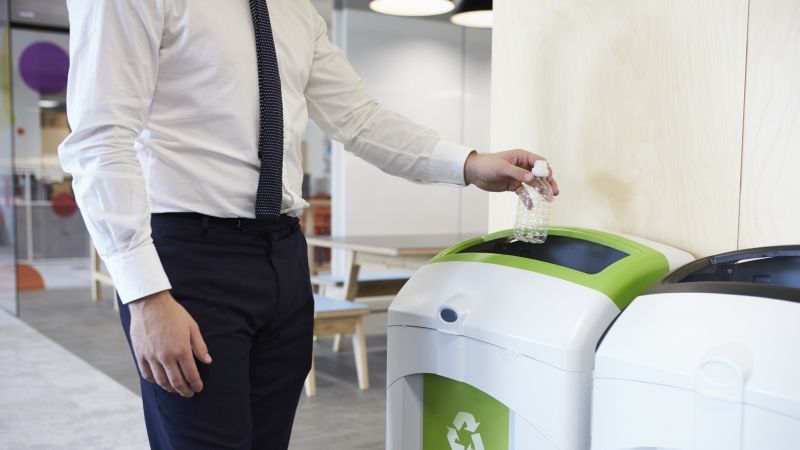Meetings and events have a dirty little secret. It's hiding in the garages and dumpsters behind the venues, in the kitchens and prep areas, and even in the wastebaskets and trash cans scattered throughout the meeting spaces.
Meetings and events create a lot of waste. According to MeetGreen, the typical conference attendee produces 4.1 pounds of waste per day. That waste comes in the form of food (including packaging and materials), banners and signage, badges, tabletops, packing materials — the list goes on and on.
“Even with a good composting and recycling program at the venue, a midsized corporate trade show with around 5,000 attendees will still go through tons of waste," event sustainability specialist Shawna McKinley writes in her 2018 "Free Guide to Better Green Meetings" on EventManagerBlog.
More than 40% of event waste ends up going into a landfill, while only 3% is donated. With more and more destinations facing pressure to protect the environment — particularly those where outdoor recreation rakes in the tourism dollars — hotels and meeting venues are having to follow suit and think about how to make their properties, meetings, and events more sustainable, all while keeping an eye on the bottom line.
Green venue tips you need to know:
Making the business case for going green
Environmental sustainability doesn't have to be at odds with providing an amazing event and maintaining costs. In fact, in many cases, sustainable initiatives can lower costs.
“In my experience, eco-efficient event practices save money in many situations, particularly when it comes to waste-wise food and beverage planning and design-for-reuse branding," McKinley says.
That's been the case for MeetGreen, a conference and event management company and sustainability consulting firm founded in 1994. Since MeetGreen started measuring its efforts in 2008, it has saved clients between $5.3 million and $7 million.
“Sustainability makes sense on so many levels for hotels and event venues," says Nancy J. Zavada, CMP, founder and president of MeetGreen. “Sustainable initiatives such as environmentally efficient HVAC systems and water-saving fixtures save money on building operating costs and also reduce an event's environmental footprint."
In addition, implementing and promoting your green credentials can bring in new sources of revenue as more and more planners seek to align themselves with sustainable venues. That helps new clients can meet their own corporate social responsibility (CSR) goals and attract new sponsors, according to McKinley.
Use green venue tips and grow your business
Ways to create greener meeting venues
It has never been easier for a venue to create a sustainable event, Zavada says. “Add in recycling, use of china instead of disposables, and local, fresh food in the outlets, and they have the first building blocks of a green event."
Here are some ideas for hoteliers to create a greener events program:
Think local. One smart way to create a more sustainable event is to cater food locally. Having a food and beverage program that uses products sourced locally doesn't just make environmental sense, it can also save on transportation costs. Plus, it gives attendees a chance to experience local flavors without having to leave the venue. The Harraseeket Inn, a 93-room luxury inn and meeting venue in Freeport, Maine, sources all of its ingredients — from organic fair trade coffee to goat cheese — from local purveyors, with leftovers being reused as compost on the property. Another option is to donate unused food to community organizations or shelters when the event is over. Venue managers can find a local food bank using the locator on Feeding America's website.
Reduce waste. Consider using technology to help meet sustainability goals, such as going paperless by replacing maps and event schedules with a mobile app. Not only will the venue save money on printing costs, but it will reduce paper waste. The National Conference Center, a training and conference center in Loudon County, Virginia, not only uses paperless check-in and digital brochures, it also provides reusable cups and glass jugs of water instead of plastic water bottles, as well as biodegradable and recyclable paper products.
Reuse and donate. For large trade shows in particular, there are a lot of leftover materials from booths and exhibits that often end up in landfills. Instead, those items could be donated to programs that benefit the local community. As part of its Sands ECO360° Meetings Program, The Venetian in Las Vegas has worked with IMEX America to create a sustainability program for the annual event since 2012. Its green initiatives include “donating 1,250 pounds of leftover exhibitor furniture and signage to Veterans Village, a housing and intensive support services organization, and a Badge Back program (that) enabled attendees to donate leftover badges and lanyards to the The Teacher's Exchange for repurposing or reuse," according to The Venetian website.
Leveraging sustainability to attract group business
The final step for a hotel or venue manager is to tell the sustainability story.
“Talk about the initiatives; make it a value-added component to your proposals," Zavada says. “What the current surveys are telling us is that there is still a communication breakdown between venues and planners. Facilities are waiting for planners to ask about green policies, and planners are expecting facilities to offer up the information without being asked. Don't worry if you aren't 100% — no one is. Get started sharing your facility's sustainable practices today."
NEXT UP: Get more tips on improving sustainability with Cvent's "Green Meetings Made Easy" guide.






